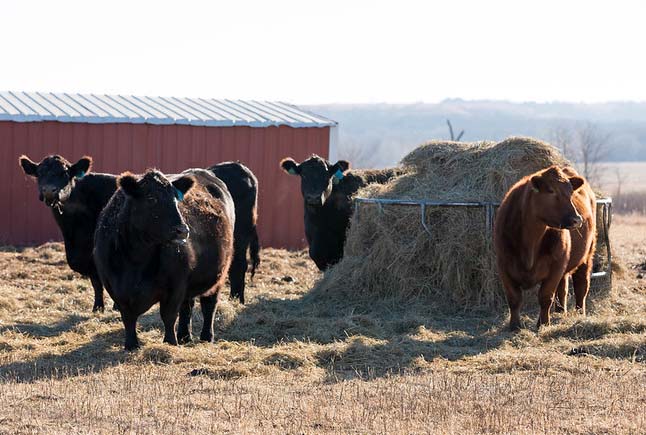
Cows in the third trimester need to consume high quality forage and are often given supplemental feed to meet their nutritional demands. | Download this photo.
Cattle Chat: Knowing when to feed hay
K-State beef cattle experts discuss ways to best meet the winter nutritional needs of the herd
Dec. 21, 2021
MANHATTAN, Kan. — When training for a sports competition, athletes often match their dietary requirements to the training regimen. In a similar way, a pregnant beef cow’s nutritional demands increase as she gets closer to the birth event, said the experts at the Kansas State University Beef Cattle Institute on a recent Cattle Chat podcast.
“As the cows move into the third trimester, the energy and protein requirements increase because that is when most of the fetal growth occurs,” said Phillip Lancaster, beef cattle nutritionist.
He said that cows that are maintained on dormant native pastures will need to receive additional feed containing both protein and energy supplements.
“The timing of when you put hay out for the cows, depends on their gestation stage and if that standing forage will meet those requirements or not,” Lancaster said.
The type of grass they are grazing will also guide the supplement decision.
“With a cool season grass like fescue, if it is green underneath the brown grass on top, it will still have good protein and digestibility and can meet the nutritional requirements of the cows,” Lancaster said.
The decision on when to put out hay also has a cost component, said agricultural economist Dustin Pendell.
“Our research shows that the most profitable cow-calf operations tend to have the lowest non-pasture feed expenses,” Pendell said. “Some producers are making trade-offs between grazing the cows a little longer on pasture versus feeding hay.”
As cattle move closer to calving, veterinarian Bob Larson said he prefers cows calve out in pasture rather than in a barn or dry lot.
To keep from damaging the new growth of those pastures during calving season, Lancaster said it is important to move the location of the feed source so that the cows are spreading their manure and minimizing the concentrated damage to the grass that comes from cows standing around a hay feeder.
Larson added: “It is important to unroll the hay in a different location each time.”
Lancaster said producers need to move the cows a little early off the pastures to allow the grass time to rest before summer grazing.
“Newly green pastures where the cows graze all the leaves off the grass early will actually stunt the growth of that grass for the growing season, which is why it is important to rotate pastures,” Lancaster said.
To hear more of this discussion, listen to the Cattle Chat podcast online.

